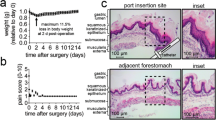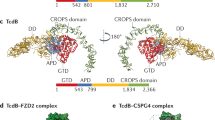Abstract
ASIATIC cholera is a disease of the gastrointestinal tract and its cardinal symptom is “rice-water” diarrhoea. The primary site of pathology is the intestinal canal where electrolytes and fluid are poured in the lumen and lost to the body. Primary systemic effects, if any, play little part in the pathogenesis of cholera. The gastrointestinal tract has naturally been the target of study for the action of cholera toxins1–3. Greenough4, however, provided strong evidence for the involvement of the duodenum by demonstrating that the aspiration of the duodenal contents in cholera patients reduced the diarrhoeal volume. Finkelstein et al.5 found in infant rabbits6 that the caecum is unresponsive to cholera toxin, while Leitch and Burrows7 found the colon of rabbit unresponsive to cholera toxin. Surprisingly enough, no studies have been carried out on the stomach, probably because no vibrio can survive in the acidic conditions of the stomach.
This is a preview of subscription content, access via your institution
Access options
Subscribe to this journal
Receive 51 print issues and online access
$199.00 per year
only $3.90 per issue
Buy this article
- Purchase on Springer Link
- Instant access to full article PDF
Prices may be subject to local taxes which are calculated during checkout
Similar content being viewed by others
References
Phillips, R. A., Ann. Rev. Med., 19, 69 (1966).
Felsenfeld, O., Bull. WHO, 34, 161 (1966).
Pollitzer, R., in Cholera (WHO, Geneva, 1959).
Greenough, W. B., Lancet, 2, 991 (1965).
Finkelstein, R. A., Atthasampunna, P., Chulasamaya, M., and Charunmethee, P., J. Immunol., 96, 440 (1966).
Dutta, N. K., and Habbu, M. K., Brit. J. Pharmacol., 10, 153 (1955).
Leitch, G. J., and Burrows, W., J. Infect. Dis., 118, 349 (1968).
Wootton, I. D. P., in Microanalysis in Medical Biochemistry, 68 (Churchill, London, 1964).
Whitehorn, J. O., J. Biol. Chem., 45, 449 (1921).
Dutta, N. K., Panse, M. V., and Kulkarni, D. R., J. Bact., 78, 594 (1959).
Koch, R., (1884), quoted by Pollitzer, R., in Cholera (WHO, Geneva, 1959).
Author information
Authors and Affiliations
Rights and permissions
About this article
Cite this article
BHIDE, M., MODAK, M. Additional Site for the Action of Cholera Toxin. Nature 223, 842–843 (1969). https://doi.org/10.1038/223842b0
Received:
Issue Date:
DOI: https://doi.org/10.1038/223842b0
Comments
By submitting a comment you agree to abide by our Terms and Community Guidelines. If you find something abusive or that does not comply with our terms or guidelines please flag it as inappropriate.



